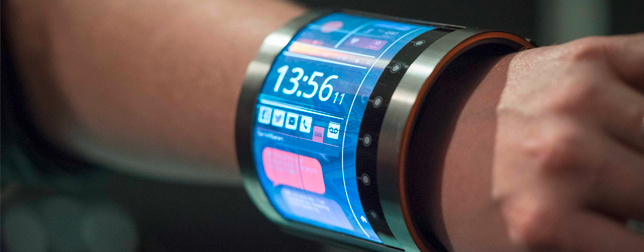Paul Cain, Strategy Director at FlexEnable, spoke at our WT | Wearable Technologies Conference 2016 EUROPE in Barcelona on February 24. We were excited to learn about their technology based on “organic electronics”. This area of development is opening amazing new design aspects – not only to the world of watches and wristbands but expanding wearables into a wide range of applications. If you missed the event, have a look at the interview below:
Can you tell our readers what FlexEnable is about?
FlexEnable is a very exciting and innovative company, based in Cambridge (UK) that has developed one of the most disruptive technologies around today. The technology is based on organic electronics and makes possible the manufacture of flexible displays and sensors. It has applications in a wide range of consumer products including wearables and mobile devices, and industries including automotive, biometrics and healthcare. By bringing this technology to the market we are fulfilling our vision to enable active surfaces in our lives: in our homes, our cars, our workplaces and even on our bodies.
How does it work? Can you reveal (a little of) the technology behind?
Our technology allows electronics to be manufactured on flexible plastic film, the thickness of a sheet of paper. It combines stable, high performance organic thin-film transistors (OTFT) with passive elements to create truly flexible and cost-effective electronics over large and small surfaces. We have demonstrated breakthroughs in displays including flexible organic liquid crystal displays (OLCD) and OLED displays, and sensors including flexible X-ray image and fingerprint sensors. The technology has already been proven commercially and we work with partners, including display manufacturers, to bring it to the market for a growing list of applications. As well as being super-flexible, it is the lowest cost route to flexible displays and sensors.
What are the biggest challenges you have / had to overcome?
Developing new technologies for hardware is hard, and we have had to develop a suite of new processes and architectures, using state of the art materials. The biggest challenge is therefore in proving such new technology in real factory environment – to be high yielding and reliable once it’s made. Today there are products on the market that use our technology – and that’s a very important milestone.
How can your solutions revolutionize the wearable market?
Consumer interest in wearable technology is growing, and this new market is still evolving, with new use cases constantly emerging. Today, most wearable devices look similar in terms of size, shape and function mainly due to form-factor constraints. The display is an important component of almost any wearable, but its rigidness limits use cases.
Organic electronics will play a key role in increasing the utility of wearables – and concurrently improving functionality and comfort for the wearer, by making displays and sensors fit and follow the form of the human body. Flexible displays and sensors will unlock new design freedom for product designers while offering end-users new look to products and improved comfort.
Currently, wearable technology is mostly limited to the wrist, but thanks to flexible electronics it can be transferred to almost any other surface such as clothing, accessories and shoes.
For example, our OLCD technology has been in the media spotlight recently following a demo of a flexible display curved into a smartwatch form factor. There was a lot of buzz around this demo that was created as proof of concept for our technology. The interest this demo generated demonstrates that there is a real need for flexible displays in consumer products that will add value to the user experience.
This technology is not limited to wearable devices. It can be integrated into mobile devices, car interiors, digital signage and other applications that will benefit from creative designs, more functionality and unbreakable screens.
What is your favorite wearable device?
I don’t have a favourite, but I am excited by the prospect of seeing the next generation of wearables. I think through this year we’ll see more and more wearable products move beyond the wrist, to other parts of the body, on our clothes and our accessories.
Wearable devices will become essential for real-time health monitoring – the ability to monitor an increasing number of vital health signs has the potential to completely change how and when health services are deployed. It is also very exciting form an individual perspective and can lead to wearables becoming an integral part of our lives.












